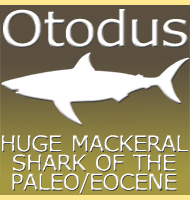


Titanoides
Name:
Titanoides
(Titan like).
Phonetic: Tie-tan-oy-deez.
Named By: Gidley - 1917.
Synonyms: Sparactolambda.
Classification: Chordata, Mammalia, Pantodonta,
Titanoideidae.
Species: T. primaevus
(type), T. gidleyi, T. looki, T. major, T.
nanus.
Diet: Herbivore.
Size: Around 3 meters long.
Known locations: Canada and the USA.
Time period: Selandian to Thanetian of the
Paleocene.
Fossil representation: Multiple specimens.
Titanoides
was one of the larger and more heavily built pantodonts and is often
described as being bear-like. However the large claws on the
plantigrade feet as well as the large canine tusks that projected
downwards from the mouth seem to have been for rooting up plants rather
than actually attacking other animals. However these features
combined with its large and powerful body meant that even though
Titanoides was a herbivore, it could have bested
most if not all of
the mammalian predators of this period.
One
former of species of Titanoides called T.
faberi, was later renamed
as a new genus, Barylambda.
Further reading
- Notice of new Paleocene
mammal, a possible relative of the Titanotheres. Proceedings of the
United States National Museum 52(2187):431-435. - J. W. Gidley - 1917.
----------------------------------------------------------------------------
Random favourites
 |
 |
 |




